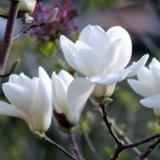
上传成功
举报
转发
2017年09月25日

胖丽丽是#风雨兰 中很勤花的一个品种,非常受花友喜欢,价格也不便宜,粉嫩嫩的花瓣,很惹人喜爱,好在风雨兰胖丽丽的养殖方法不难,绝大多数的花友都能够驾驭它。
[图片]胖丽丽生性强健,耐旱抗高温,栽培容易,开花性相当好,经常爆盆,生长适温为22~30度,花期5-11月,北方稍短些,夏天开的颜色艳,春秋天开的颜色淡,有时初花或光照不足的也开得颜色淡。
土壤:栽培土质以肥沃的砂质壤土为佳,球根一般都喜欢疏松透气的土壤。
栽培方法和要点:坛缘栽每1穴植3~5个球,穴距约15厘米,盆栽每17厘米盆植5~7个球,栽植后注意灌水保持湿度。
栽培地点要日照充足,荫蔽处不易分生子球,也不容易开花(据说有明亮散光下养殖的胖丽丽开花还可以)。
肥料:可使用有机肥料如油粕、堆肥或氮、磷、钾肥料,沤过的鸡粪肥之类的。每2~3个月施用1次,按比例增加磷、钾肥(比如必旺,必开花之类的肥料),能促进球根肥大,开花良好。
[图片]植株丛生而显拥挤时,必须强制分株(可以这个时候分株繁殖)。
风雨兰大部分品种都不耐寒,冬天低于零度时要搬回室内,户外地栽的要把球挖起来,放室内通风干燥出存放,第二年春天再种下。
...显示更多
文章
举报
转发
2017年09月25日

一、#君子兰
1、缺少磷钾肥
磷、钾能够促进花芽的分化,而氮肥则会促进君子兰叶片的生长。
解决方法:
在君子兰开花之前,要多施磷钾肥,比如,磷酸二氢钾、充分腐熟的鱼虾壳或者是鱼肠水、蛋壳、骨粉等等。
大约7~10天1次,注意薄肥勤施。
2、光线不足
君子兰不能暴晒,可能不少花友会把君子兰放在比较荫蔽的地方,君子兰不能接触到足够的光照,光合作用减弱,自然就没办法提供更多的养分让它分化花芽了~
解决方法:
最好将君子兰能放在隔着玻璃的南阳台上,同时每隔1周转一下花盆,不然君子兰的叶子容易长歪。
[图片]二、长寿花
1、光照不够充足
长寿花喜光,只有光照充足才能长势良好,光照不足的话,枝叶徒长,枝条细弱,能长出花苞来才是怪了!
解决方法:
将长寿花放在南阳台或者是南窗台,这种光照非常好的地方哦~
2、肥料不足
长寿花的花期非常长,一年能开好多次花,这也就意味着对肥料的需求很大,因此,一直不给长寿花施肥,还想让它开爆盆,就是一件非常玄幻的事情了~
解决方法:
现在正好是长寿花的花芽分化期,需要每周1次充分腐熟的鱼肠水等,比例为1:50。想要速效的话,可以直接喷磷酸二氢钾,很管用的。
[图片]三、三角梅
1、浇水问题
三角梅喜欢湿润的环境,所以一般养殖三角梅的花友,浇水都会比较多,但是一直保持湿润的环境,就很容易造成三角梅光长叶子不开花的后果。
解决方法:
控水,大概15~20天浇水1次,同时多晒太阳,让三角梅产生危机感,循环2~3次,三角梅就会长花苞了。
2、光照不足
有些花友是在室内养殖的三角梅,可能放置的位置不是很恰当,光照不是很充足,所以三角梅就会不开花。
解决方法:
三角梅最好能露天养殖,光照越好开花越多,如果没有露天的条件,请务必放在光照非常好的南阳台,谢谢。
3、枝条过于密集
三角梅很容易生出侧枝来,不少花友都舍不得剪掉,但实际上,这些枝条会分散营养,从而导致枝条上不容易生出花芽。
解决方法:
每年春天的时候都要把弱枝、病枝、徒长枝条减掉,减少养分的消耗,开花后也要把花梗剪掉哦。
[图片]四、蟹爪兰
1、温度过低
蟹爪兰的适宜生长温度为15℃以上,但是它的花期却在10~来年2月份,而这段时间内,正好气温都比较低,如果室内的温度不能达到15℃以上,它就会很难孕育花蕾的。
解决方法:
将蟹爪兰放在室内养殖。
如果冬天室内的温度也达不到15℃以上的话,可以用塑料袋给蟹爪兰做一个小温室。
2、总是搬来搬去
有些花友为了让蟹爪兰有充足的光照就会把它搬来搬去,殊不知,这才是导致蟹爪兰不开花的元凶啊!而且长出了花苞的蟹爪兰也会掉苞!
解决方法:
将蟹爪兰放在隔着玻璃的南阳台即可~
五、月季
1、没有及时修剪
月季长的很快,在生长的过程里,会长出很多的侧枝啊,横生枝条之类的,这种枝条会分散养分,从而导致每根枝条上的养分都不够分化花芽的。
解决方法:
将月季的徒长枝条、细弱枝条、干枯枝条、生病的枝条以及花后枝条全都剪掉!
2、缺少肥料
开花对于月季来说,是一件非常消耗养分的事情,如果不能及时补充肥料,月季不能积攒足够的营养,当然就没法开花了~
解决方法:
一般10天就要施1次充分腐熟的稀薄饼肥,在月季的生长旺季则是要1周1次哦~
[图片]六、茶花
1、温度太低
茶花要在10~15度左右的温度才能产生花芽,如果温度达不到,花蕾就孕育不出来,或者是孕育出来花蕾了,结果温度一降低,全都掉了……
解决方法:
冬天的时候把茶花放在室内养护,放在南阳台等地方,而且不要随便挪动,总是挪动,茶花会死。
2、湿度不够不通风
茶花喜欢湿润的环境,养殖的时候,最好每天往茶花的叶子上喷水,增加空气湿度,同时也要每天开窗通风,一直闷着的话,也会造成落蕾哦~
[图片]七、茉莉
1、光照不足
茉莉喜光,非常喜光,如果光照不足,花芽无法分化,自然就不开花了。
解决方法:
有条件的进行露养,没条件的就放在南阳台上,一定要光照充足才行!
2、土壤偏碱
茉莉是南方花卉,喜欢微酸性的土壤,北方花友养护的时候可能会忽略掉这一点,殊不知这就是你家茉莉不开花的原因啊!
解决方法:
每次浇水的时候加入1~2滴醋,或者用硫酸亚铁进行灌根,比例是1:1000,大概1周1次即可。
[图片]八、菊花
1、光照太多
菊花是短日照植物,每天的日照时间太长,菊花的花芽就不会分化,而且灯光也是光,也会影响到的。
解决方法:
如果晚上家里非常亮堂的话,最好给菊花关小黑屋,或者是直接进行露养。
2、肥料不足
开花就要消耗营养,不施肥还想开的好,世界上就没这么容易的事儿~
解决方法:
从立秋之后,1周施1次稀薄的骨片酱渣水,等到含苞待放的时候,再加1次磷酸二氢钾溶液,比例是1:1000,开花会更艳丽哦~
[图片]九、桂花
1、时间不够
播种繁殖的桂花,10年左右才能开花;嫁接、压条、分株等方法繁殖的桂花,一般次年即开花;扦插的桂花,一般4年才开花。
解决方法:
所以想想你的桂花是怎么繁殖的,如果是扦插的,先等4年再说吧~
2、肥料不足
没有营养物质,桂花就是想开花也是有心无力呀,所以亲爱的花友们,一定要给桂花施肥!
解决方法:
桂花喜猪粪。施肥从春天就要开始了,4~5月期间,10~15天施1次,6~7月期间,7~10天施一次,8月初施最后一次,一般这样,桂花就能开出一大团一大团的花来了!
一般城市里没有猪粪,可用腐熟的饼肥液代替哦,如果能弄到猪粪的话,还是建议先用猪粪。
3、土壤不合适
桂花也是喜欢微酸性的土壤,盆土过碱,会影响桂花的正常生长,就更不要说开花了~
解决方法:
一般盆栽可用腐叶土+沙壤土,按照1:1的比例进行配置。也可以在平时浇水的时候加入2~3滴醋或者是硫酸亚铁~
[图片]十、杜鹃
1、缺少磷钾肥
杜鹃不开花的主要原因是缺少磷钾肥,磷钾肥才是促进杜鹃形成花芽的主力。
解决方法:
在花芽分化期,及时补充磷钾肥,比如草木灰(含有钾肥)、蛋壳(磷肥)、腐熟的动物碎骨(磷肥)等等,在花盆中埋入适量,很快就能开花啦~
2、浇水太多
排水不良,过于湿润,会引起杜鹃叶子枯黄等一系列的问题,从而导致无法孕育花蕾。
解决方法:
配土一定要疏松透气,可以使用腐熟细松针土+粗沙,不要用粗长的松针,比例是4:1。
同时浇水也要注意,一般室内养的杜鹃是3~5天浇水1次,保持土壤微微湿润就可以。
[图片]十一、兰花
1、光照不足
兰花虽然不喜欢烈日暴晒,但是也不意味着过于荫蔽,如果长期将兰花放在室内荫蔽的地方,光合作用不够,肯定是没法开花的。
解决方法:
最适合放置兰花的地方就是靠南的窗户和阳台,而且要时常打开窗户通风哦~
2、肥水管理不当
兰花的浇水是一大学问,如果浇水做不好,很容易就会造成烂根等问题,就更不用说开花了。
解决方法:
浇水一定要见干见湿,保持土壤微微湿润即可。
兰花需要施薄肥,一般半个月施肥1次,每次用稀薄的腐熟豆饼水即可。
[图片]十二、牡丹
1、没有经过春化
牡丹开花之前,必须经过一次低温处理才行,就是在0~10℃的环境中过2~3个月,很多花友到了冬天就把牡丹搬进室内,温度根本达不到,所以牡丹就没法开花。
解决方法:
冬天的时候别把牡丹搬进室内,牡丹能耐零下30度左右的低温,你的担心都是多余的!
2、肥水不当
牡丹开花需要充足的养分,开花前施肥一定要足,大约1周1次充分腐熟的饼肥。
解决方法:
牡丹孕蕾期需控制浇水,抑制枝叶生长。如果浇水过多,则易引起叶片徒长,就会出现只长叶子不开花的现象。
[图片]只要掌握了正确的方法,
想让花开不断,
还是很简单的哦!
...显示更多
文章
滚动加载更多...
article







